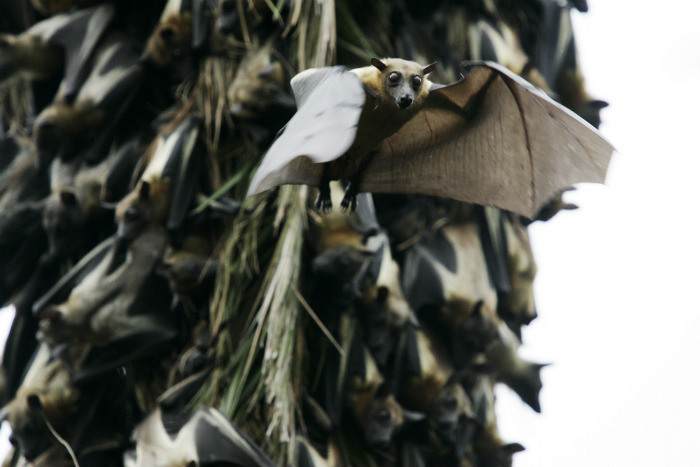By: Brendon Lee
Send to a friend
The details you provide on this page will not be used to send unsolicited email, and will not be sold to a 3rd party. See privacy policy.
People in South-East Asia and central Sub-Saharan Africa are particularly at risk of viral diseases carried by bats, a map shows.
The global risk map is designed to support research into avoiding the transfer of diseases from bats to humans and to help health workers pinpoint infection hotspots and target pre-endemic measures, its creators say.
Analysing data published between 1900 and 2013, the scientists measured each region’s risk level (see map below) and identified factors that contribute to infections from bats, such as increased human encroachment on areas where bats roost.
While deforestation and urbanisation were found to be a common risk factor throughout all regions, scientists warned that other human activities — such as hunting bats for meat and traditional medicines — could also cause an outbreak.
“Bats have been suspected as the origin of several recent major human virus epidemics, including the Nipah virus in 1999, SARS coronavirus in 2002 and, more recently, the Ebola virus,” says Liam Brierley, the lead author of the research published on 5 January in The American Naturalist, and a researcher at the Zoological Society of London, United Kingdom.
Some bat species live in colonies with millions of individuals, which could facilitate the transmission of multiple viruses at the same time.
“Although it has not yet been properly understood, bats have been known to down-regulate their body temperature at night,” explains Brierley. “This state of torpor might explain how their immune systems are able to cope with multiple infections.”
The researchers suggest putting areas with many bat colonies and lots of different viruses under surveillance to check for the emergence of novel viruses that could jump to humans. Areas with high potential for contact between humans and bats, such as rural settlements, would then require immediate public health interventions if a new virus emerged, they say.
For instance, one of the largest virus outbreaks in South-East Asia involved the Nipah virus, which was traced to pig farm expansions close to bat habitats in Malaysia. Research indicates that bat-to-pig-to-human transmissions are likely to have occurred when pigs ate fruit contaminated by bat saliva or urine.
“As the population in South-East Asian countries continues to expand, we have to be mindful of the risks of moving into forested tropical areas,” says Peter Hotez, president of the Sabin Vaccine Institute, a US-based research organisation. “We need to build our capacity to develop human veterinary vaccines for these zoonotic infections.”
But despite enormous capacity among South-East Asian countries to innovate and develop new vaccines, many local vaccine developers choose not to do so because they fear their products will not sell, he says.
“We need to identify financial mechanisms for supporting indigenous vaccine producers and non-profit product development partnerships,” says Hotez. He adds that the general public, in particular farmers working near bat habitats, must be informed about the risks.
References
Liam Brierley and others Quantifying global drivers of zoonotic bat viruses: a process-based perspective (The American Naturalist, 5 January 2016)















